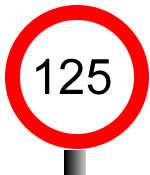Slow zone
A slow zone, in the United States, is an area where a train is forced to slow down for either structural, construction, power, signal, or track problems. Slow zones limit a train to about 10-35 MPH. Notification to train crews is referred to as a "slow order."
Speed restrictions in the United Kingdom
Permissible Speed

In the UK, every section of railway line has a maximum speed, known as the Permissible speed.[1] Where there is a change in permissible speed on a line a permissible speed indicator sign will show the new speed. Table A of the Network Rail Sectional Appendix provides a list of these. Train crew are expected to know every permissible speed for all the routes they work over as part of their Route knowledge.
Speed restrictions

Occasionally it is necessary to run trains at a lower speed than the permissive speed in order to carry out maintenance or repairs. There are three types of speed restriction that are used;
A Temporary speed restriction (TSR) is a planned operation which is published in the Weekly operating notice.[1] It consists of a temporary AWS magnet located 180 metres before a warning board showing the speed required. At the service braking distance based on the permissible speed of the line is located a speed indicator, marking the commencement of the TSR. At the end of the TSR is located a Termination board.[2]
If a TSR is 'eased' to show a higher speed than in the Weekly operating notice, the warning boards and speed indicator are adjusted to show this. If the TSR is removed earlier than published, the warning boards and speed indicator show either the permissible speed or a SPATE indicator.[3]
An Emergency Speed Restriction is a speed restriction which has not been published in the Weekly Operating Notice. This also includes a speed restriction that has been published, but the times, speed or mileage of which are different from those published. A speed restriction that has been re-imposed after being withdrawn early is treated as an emergency speed restriction. A temporary speed restriction that has been shown in an amendment to the Weekly Operating Notice is treated as an emergency speed restriction.
A Blanket speed restriction applies to an area rather than a geographical location.
See also
References
- 1 2 "Rulebook Master: Module SP. Section 1-5 "Speed - Definitions"" (pdf). Network Rail. Retrieved 2017-02-07.
- ↑ "Rulebook Master: Module SP. Section 3.2 "Normal arrangements"" (pdf). Network Rail. Retrieved 2017-02-07.
- ↑ "Rulebook Master: Module SP. Section 3.11 "When a TSR is eased or removed early"" (pdf). Network Rail. Retrieved 2017-02-07.